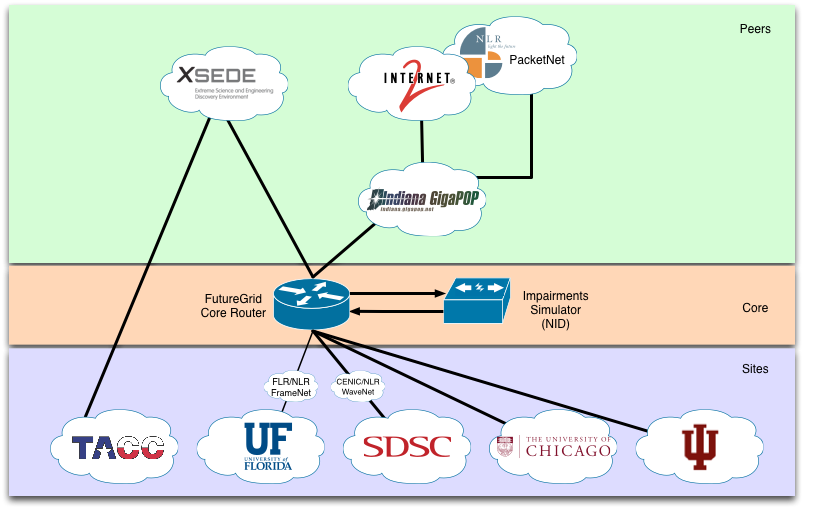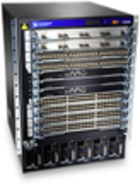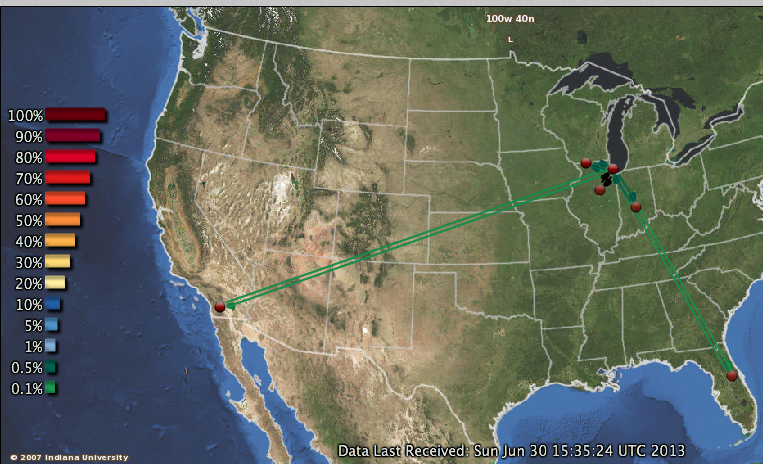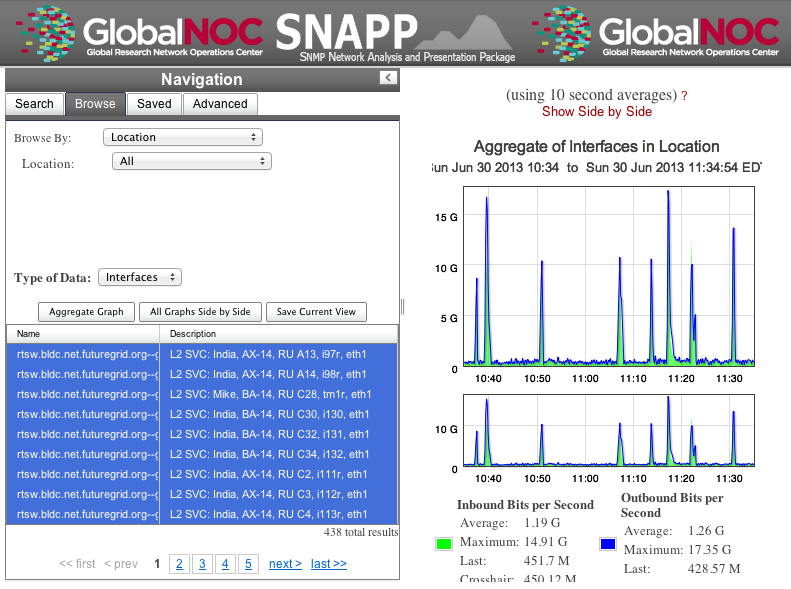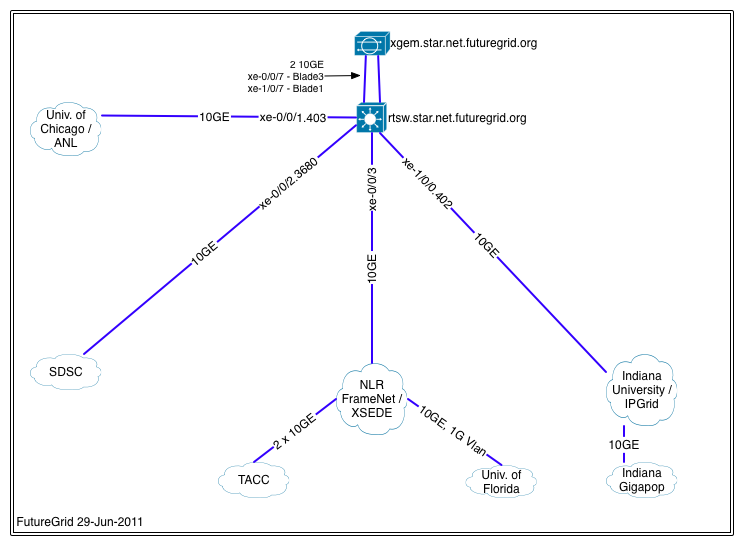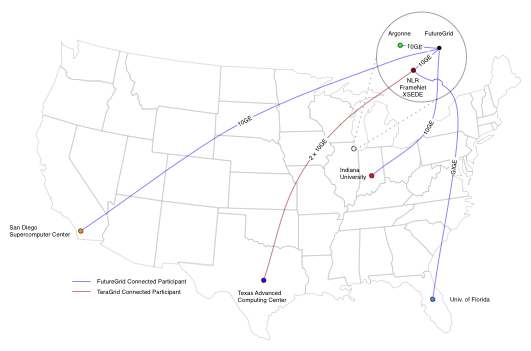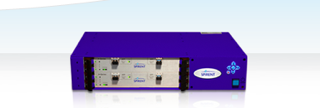4.1. Hardware
FutureGrid is built out of a number of clusters of different types and
sizes that are interconnected with up to a 10GB Ethernet between its sites.
The sites include Indiana University, University of Chicago, San Diego
Supercomputing Center, Texas Advanced Computing Center, and University
of Florida.
The tables Overview of the Clusters and Selected Details of the Clusters show an
overview of some imporatnt information about these clusters.
Overview of the Clusters
| Name |
System Type |
# Nodes |
# CPUS |
# Cores |
TFLOPS |
RAM (GB) |
Storage (TB) |
Site |
|---|
india
|
IBM iDataplex
|
128
|
256
|
1024
|
11
|
3072
|
335
|
IU
|
hotel
|
IBM iDataplex
|
84
|
168
|
672
|
7
|
2016
|
120
|
UC
|
sierra
|
IBM iDataplex
|
84
|
168
|
672
|
7
|
2688
|
96
|
SDSC
|
foxtrot
|
IBM iDataplex
|
32
|
64
|
256
|
3
|
768
|
0
|
UF
|
alamo
|
Dell Poweredge
|
96
|
192
|
768
|
8
|
1152
|
30
|
TACC
|
xray
|
Cray XT5m
|
1
|
166
|
664
|
6
|
1328
|
5.4
|
IU
|
bravo
|
HP Proliant
|
16
|
32
|
128
|
1.7
|
3072
|
128
|
IU
|
delta
|
SuperMicro GPU Cluster
|
16
|
32
|
192
|
|
1333
|
144
|
IU
|
lima
|
Aeon Eclipse64
|
8
|
16
|
128
|
1.3
|
512
|
3.8
|
SDSC
|
echo
|
SuperMicro ScaleMP Cluster
|
16
|
32
|
192
|
2
|
6144
|
192
|
IU
|
Selected Details of the Clusters
| Name |
Echo |
Alamo |
Bravo |
Delta |
Foxtrot |
Hotel |
India |
Sierra |
xray |
|---|
Organization
|
|
Texas Advanced Computing Center
|
Indiana University
|
Indiana University
|
University of Florida
|
University of Chicago
|
Indiana University
|
San Diego Supercomputer Center
|
Indiana University
|
Machine Type
|
Cluster SclaeMP
|
Cluster
|
Cluster
|
Cluster
|
Cluster
|
Cluster
|
Cluster
|
Cluster
|
Cluster
|
System Type
|
SuperMicro
|
Dell PowerEdge M610 Blade
|
HP Proliant
|
|
IBM iDataPlex dx 360 M2
|
IBM iDataPlex dx 360 M2
|
IBM iDataPlex dx 360 M2
|
IBM iDataPlex dx 340
|
Cray XT5m
|
CPU type
|
Intel Xeon E5-2640
|
Intel Xeon X5550
|
Intel Xeon E5620
|
Intel Xeon 5660
|
Intel Xeon X5520
|
Intel Xeon X5550
|
Intel Xeon X5550
|
Intel Xeon L5420
|
AMD Opteron 2378
|
Host Name
|
echo
|
alamo
|
bravo
|
delta
|
foxtrot
|
hotel
|
india
|
sierra
|
xray
|
CPU Speed
|
2.50GHz
|
2.66GHz
|
2.40GHz
|
2.80 GHz
|
2.26GHz
|
2.66GHz
|
2.66GHz
|
2.5GHz
|
2.4GHz
|
Number of CPUs
|
|
192
|
32
|
32
|
64
|
168
|
256
|
168
|
168
|
Number of nodes
|
12
|
96
|
16
|
16
|
32
|
84
|
128
|
84
|
1
|
RAM
|
|
12 GB DDR3 1333Mhz
|
192 GB DDR3 1333Mhz
|
192 GB DDR3 1333 Mhz
|
24 GB DDR3 1333Mhz
|
24 GB DDR3 1333Mhz
|
24 GB DDR3 1333Mhz
|
32 GB DDR2-667
|
8 GB DDR2-800
|
Total RAM (GB)
|
|
1152
|
3072
|
3072
|
768
|
2016
|
3072
|
2688
|
1344
|
Number of cores
|
144
|
768
|
128
|
|
256
|
672
|
1024
|
672
|
672
|
Operating System
|
|
Linux
|
Linux
|
Linux
|
Linux
|
Linux
|
Linux
|
Linux
|
Linux
|
Tflops
|
|
8
|
1.7
|
|
3
|
7
|
11
|
7
|
6
|
Disk Size (TB)
|
2.8
|
48
|
|
15
|
20
|
120
|
335
|
72
|
335
|
Hard Drives
|
|
500 GB Internal 7200 RPM SAS Drive
|
6x2TB Internal 7200 RPM SATA Drive
|
Seagate Constellation 7.2 K RPM 64 MB Cache SATA 92GB
|
500 GB Internal 7200 RPM SATA Drive
|
1 TB Internal 7200 RPM SATA Drive
|
3000 GB Internal 7200 RPM SATA Drive
|
160 GB Internal 7200 RPM SATA Drive
|
6 TB Internal Lustre Storage
|
Primary storage shared by all nodes
|
|
NFS
|
NFS
|
NFS
|
NFS
|
GPFS
|
NFS
|
ZFS filesystem with 76.8 TB raid2 storage and 5.4 TB of raid0 (for scratch)
|
NFS
|
Storage details
|
|
|
|
RAID 9260-4i 1pt SAS2 512 MB SGL
|
|
|
|
|
|
Connection configuration
|
|
Mellanox 4x QDR InfiniBand adapters
|
Mellanox 4x DDR InfiniBand adapters
|
|
|
Mellanox 4x DDR InfiniBand adapters
|
Mellanox 4x DDR InfiniBand adapters
|
Mellanox 4x DDR InfiniBand adapters
|
Cray SeaStar Interconnect
|
Primary storage shared by all nodes
|
|
|
|
92 ????
|
|
|
|
|
|
CPUs (cores) per node
|
|
|
|
2
|
|
|
|
|
|
Cores per CPU
|
|
|
|
6
|
|
|
|
|
|
Total number of GPU cores
|
|
|
|
192
|
|
|
|
|
|
GPU type
|
|
|
|
nVIDIA Tesla C2070
|
|
|
|
|
|
Cores per GPU
|
|
|
|
448
|
|
|
|
|
|
GPUs per node
|
|
|
|
2
|
|
|
|
|
|
Batch system
|
|
|
|
Torque
|
|
|
|
|
|
FutureGrid systems team members are working on enhancements that could lead to increase in the number of cores, memory size, and scratch space. We will keep you up to date on the developments.
Storage Resources
| System Type |
Capacity (TB) |
File System |
Site |
|---|
| DDN 9550 |
339 shared with IU + |
Luster |
IU |
| Data Capacitor |
16 TB dedicated |
|
|
| DDN 6620 |
120 |
GPFS |
UC |
| SunFire x4540 |
96 |
ZFS |
SDSC |
| Dell MD3000 |
30 |
NFS |
TACC |
| IBM dx360 M3 |
24 |
NFS |
UF |
| Resource Name |
Network Devices |
|
|
|---|
| IU Cray |
Cray 2D Torus SeaStar |
|
|
| IU iDataPlex |
DDR IB |
QLogic switch with Mellanox ConnectX adapters |
Blade Network Technologies & Force10 Ethernet switches |
| SDSC |
DDR IB |
Cisco switch with Mellanox ConnectX adapters |
Juniper Ethernet switches |
| TACC |
QDR IB |
Mellanox switches and adapters |
Dell Ethernet switches |
| UC |
DDR IB |
QLogic switch with Mellanox ConnectX adapters |
Blade Network Technologies & Juniper switches |
| UF |
Ethernet only (Blade Network Technologies & Force10 switches) |
|
|
The FutureGrid network provides connectivity among FutureGrid
participants, and network access to the Network Impairments Device
(NID). Five participants connect through a variety of network
providers (see Figure: Logical Network Diagram). Interconnects at the Indiana
Gigapop, Internet2 and NLR extend access to FutureGrid resources to
researchers nationally and internationally.
Todo
inaccurate atlas diagram, can not change as network group has no
info, however wil lead to confusion, needs to be stated
Todo
proxy router is mentioned, but we seem only to have
dosabled commands, which commands can users do?
FutureGrid deployed a Juniper EX8208 at the Core in Chicago’s
StarLight facility. The Juniper EX series provides for Layer2 and
Layer3 connectivity. FutureGrid uses the EX to fulfill the network
services (i.e., interconnectivity and external connectivity). The EX
provides a special feature labeled ‘firewall based forwarding’,
allowing seamless integration with network impairments.
The GlobalNOC at Indiana University provides network engineering
services, and email and phone support. GlobalNOC resources for public
WAN information can be found at http://noc.futuregrid.org/. Available tools include:
As IPv6 test beds are not available at all FutureGrid partner sites,
early implementation of iPv6 would slow important software development
work. As a result, current plans call for FutureGrid to continue using
IPv4.
Below is further information about networking:
| Resource |
Network Switch |
Link |
|---|
| FutureGrid Core |
Juniper EX8200 |
|
| India |
Force10 C-150 |
Juniper/Dell EX series Force 10 |
| Bravo |
Force10 S60 |
force10-s60 |
| Delta |
Force10 S60 |
|
| Echo |
Force10 S60 |
|
| Sierra |
Juniper EX4200 |
|
| Hotel |
Juniper EX4200 |
|
| Alamo |
Dell PowerConnect 6000 Series |
Dell, PowerConnect |
| Alamo |
Dell PowerConnect 6224 |
|
| Xray |
Force10, C-150 |
Force10-c150 |
| foxtrot |
internal network switch: IBM/BLADE Rack Switch G8000 and public
network switch: Force10 S50 |
|
| Node NICs |
built-in (IBM iDataPlex DX360 M2) dual Intel 82575EB Gigabit Network Connection
10Gbps, Myricom Myri-10G Dual-Protocol NIC (available on login
node) |
|
Todo
network swithes inside india not corerct
Researchers on FutureGrid may periodically employ the use of a Spirent
XGEM, a Network Impairments Emulator. The XGEM allows users to
accurately create the delays and impairments that occur over live
production networks for validating and evaluating new products and
technologies. The XGEM supports a variety of impairments with the most
common being delay, packet loss, jitter and re-ordering.
The XGEM contains two blades, each with a 10GE interface. Traffic
received on one blade is automatically transmitted on the other blade,
and vice-versa. This allows the XGEM to be deployed as a pass-through
device. Impairments are applied unidirectionally. An identical or
different impairment can be applied in either direction, or
simultaneously in both directions.
FutureGrid also utilizes a Juniper EX8208 as the primary network
element between all of the FutureGrid participants. Juniper’s EX
platform contains firewall-based forwarding, which allows us to insert
the XGEM between FutureGrid participants with only software changes (see
Figure 1).
The firewall-based forwarding feature can be configured to forward
traffic unidirectionally or bidirectionally through the XGEM using a
single IP address or any size subnet. Only traffic defined by the
Juniper EX8208 will be impaired, leaving all other traffic between
FutureGrid participants unaffected.
This implementation requires traffic to traverse the FutureGrid Core
in order to be impaired. Additional configuration might be required at
the participants’ individual sites for impairments to occur locally.
 FutureGrid
0.1
FutureGrid
0.1
